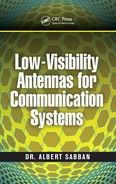Preface
The main objective of Low-Visibility Antennas for Communication Systems is to present new low-visibility antennas. To provide a background, Chapters 1 and 2 cover electromagnetics and basic theory and fundamentals of antennas to assist electrical engineers and students. There are many electromagnetic theory and antenna books for electromagnetic scientists. However, there are few books that help electrical engineers and undergraduate students to study and understand basic electromagnetic and antennas theory and fundamentals with few integral and differential equations.
Several types of 3D full-wave electromagnetics software are available, such as the High-Frequency Structural Simulator (originally, now HFSS), Advanced Design System (ADS), and Computer Simulation Technology (CST) used to design and analyze antennas. Antennas developed and analyzed in this book were designed by using HFSS and ADS software. For all the antennas presented in this book there was a good agreement between computed and measured results. Only one design and fabrication iteration was needed in the development process of the antenna presented.
Electromagnetic theory and transmission lines are discussed in Chapter 1. An introduction to antennas is given in Chapter 2. Low-visibility printed antennas are presented in Chapter 3. Antenna arrays are the subject of Chapter 4. Applications of microstrip antenna arrays are discussed in Chapter 5. Also, millimeter wave (MM) microstrip antennas are presented in Chapter 5. Wearable antennas for medical applications are presented in Chapter 6, and antenna S11 variation as a function of distance from the human body is discussed in Section 6.4. Wearable tunable printed antennas for medical applications are presented in Chapter 7. New wideband wearable meta-material antennas for communication applications are presented in Chapter 8, and meta-material antenna characteristics in the vicinity of the human body are discussed in Section 8.6. Low-visibility fractal printed antennas are presented in Chapter 9. Microwave and MM wave technologies—microwave integrated circuits (MIC), monolithic microwave integrated circuits (MMIC), micro-electro-mechanical systems (MEMS), and low-temperature co-fired ceramics (LTCC)—are presented in Chapter 10. Radio frequency and antenna measurements are presented in Chapter 11.
Each chapter in the book covers sufficient details to enable students, scientists from all areas, and electrical and biomedical engineers to follow and understand the topics covered in the book. The book begins with elementary electromagnetics and antenna topics needed by students and engineers with no background in electromagnetic and antenna theory to study and understand the basic design principles and features of antennas, printed antennas, compact antennas with low visibility, and wearable antennas for communication and medical applications. This book may serve students and design engineers as a reference book.
Several topics and designs are presented in this book for the first time. These include new designs in the areas of wearable antennas, meta-material antennas, and fractal antennas. The text contains sufficient mathematical detail and explanations to enable electrical engineering and physics students to understand all topics presented in this book.
Several new antennas are presented in this book. Design considerations and computed and measured results of the new antennas are presented in the book.
